Sloan 2016: 50 NBA notes, quotes and anecdotes from analytics conference

BOSTON — The Golden State Warriors’ dominance knows no bounds. Having already conquered the NBA with a championship, historic regular season and transcendent style of play, the team expanded its reign by becoming this year’s “it team” in the analytics community.
Not only did the Warriors win “Best Analytics Organization” at the 2016 MIT Sloan Sports Analytics conference, but GM Bob Myers brought down the house with the best line of the weekend (albeit one borrowed from Davidson head coach Bob McKillop.)
“Analytics are like a bikini,” Myers said. “They show a lot, but they don’t show everything.”
• On the road with the Warriors | What keeps Warriors from winning 73?
To put it in appropriate terms, Golden State’s usage rate was off the charts at this year’s annual Sloan gathering. The team seemed to be mentioned in every panel and presentation, generating awe as easily as they generate points. But while the team was undoubtedly the darlings of this year’s conference, Jeff Van Gundy, the lovable former coach and current curmudgeon, warned against painting the Warriors as analytics geniuses due to their recent success.
“So the Warriors do everything right because [Stephen] Curry hits 40-footers?” he joked.
As the Sloan conference celebrated its 10th anniversary this year, it continued its trend away from pure analytics discussions to mixed conversations of funny anecdotes and nerd vs. jock debates. That isn’t so much a criticism as an observation. With 3,900 people in attendance this year—including representatives from every NBA team, 80% of the NFL and 70% of MLB/NHL—the conference has simply become too mainstream for insiders to be tipping their hands.
That didn’t stop it from being an educational and entertaining experience. Without further ado, here are 50 notes, quotes and anecdotes from this year’s festivities.
(For a stroll down memory lane, check out my recaps from 2014 and 2015.)
Notes
1.One of the most interesting papers presented at Sloan this year centered around ball screens. Using SportVU tracking data, the researchers analyzed 270,823 screens and examined how teams perform when going over, under, switching and trapping. Arguably the most surprising finding: more teams go under ball screens than ever despite the new premium on long-distance shooting.
2. From that same paper, here's a look at the best combos from 2013–14 defending the pick-and-roll in over, under and switch scenarios. As the researchers from Michigan and MIT note, there’s no defensive combo that excels at all three.
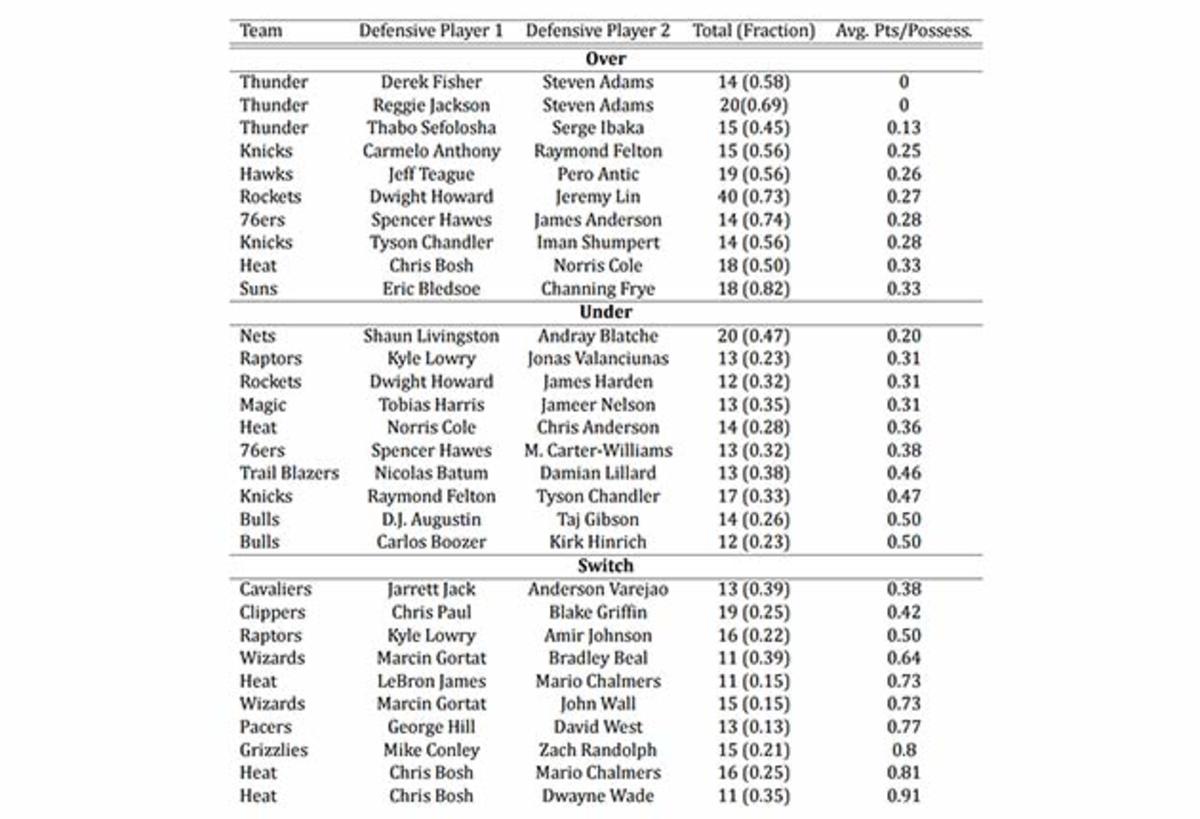
4. Being selfish pays off. As the paper showed, players are largely rewarded for their individual accomplishments, not their team contributions. “The results indicate that players are largely paid for their individual statistical output on offense." The paper added that NBA teams are “not doing a good job of identifying the value a player brings to a team through his complementarities with existing players.” Draymond Green is very much the exception to the rule.
5. Prepare yourself for some absolutely ridiculous contracts this off-season. With the NBA salary cap set to spike, teams are going to offer Brink’s trucks to free agents despite very few All-Star-calibers players on the market. Why will teams overpay for middling talent? Money will increase this summer, but talent won’t. “When you make a resource more scarce, you raise its value,” sports agent David Falk explained during a panel on negotiating. In a later panel, Rockets GM Daryl Morey echoed the same sentiments. With more money around but not more max-level talent, the Rockets GM concluded, “It’s going to be tough to have a good free agency.”
• SHARP: Trade deadline sets NBA up for crazy summer | KD’s free agency
6. The negotiating panel was asked who was the toughest negotiator they ever faced. Some of the answers: Jerry Reinsdorf (from Falk), Jay Z (from Michael Yormark) and Danny Ainge (from Morey).
7. From ’10 to 2015, NBA teams lost an average of $10 million–$50 million in salary per year due to injuries, according to researchers from the Dow Jones and Wall Street Journal.
8. Using their injury prediction model, which shows overuse can lead to injuries, the researchers claim they could have prevented 60% of injuries from ’10 to 2015 by resting the top 20% of high-risk players. Below is a lift curve that shows their findings. The curved line shows a 300% improvement over chance (diagonal line).
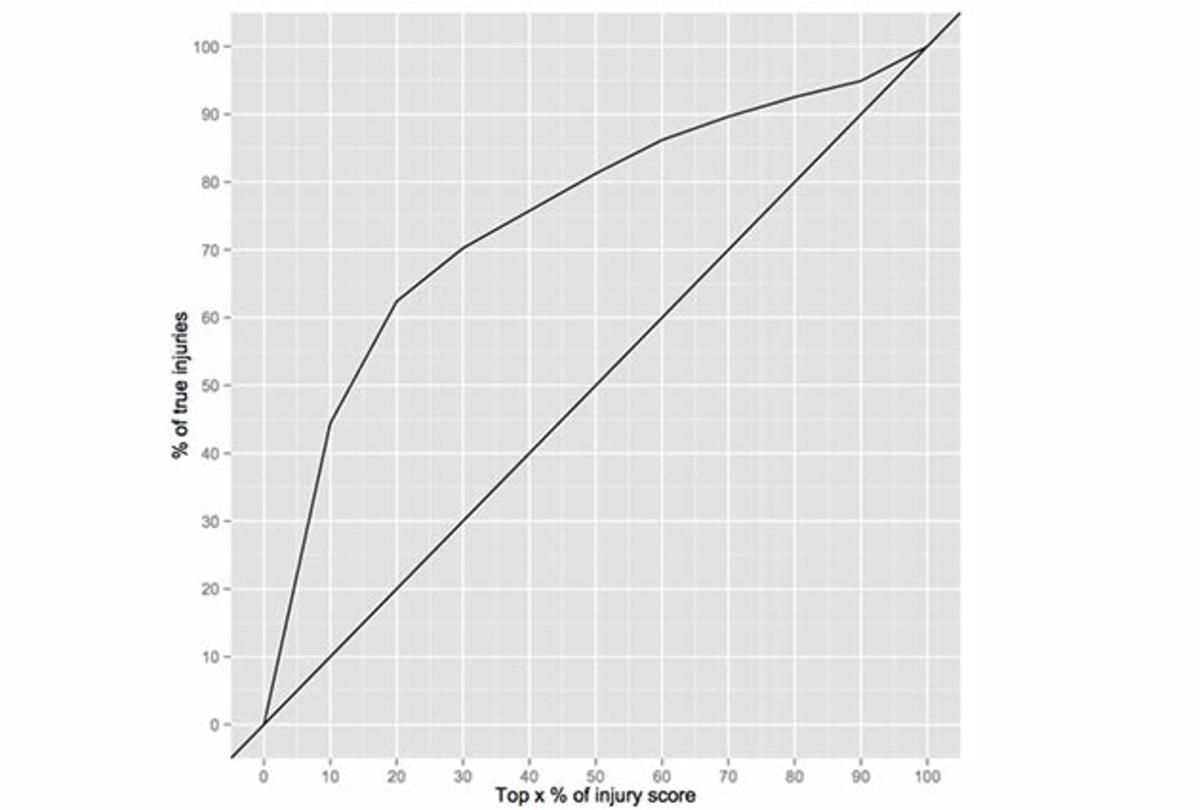
9.
10. Sue Bird revealed her best life hack at the Sloan conference: Coffee naps. What’s that, you ask? Drink a cup of coffee, turn the lights and your phone off, snooze for 20–30 minutes and wake up with the benefit of both caffeine and a little sleep. I have no idea if this is a thing or not, but you can bet I'll be trying it out immediately.
11. Can’t we all just get along? If the four major sports leagues could, they could save hundreds of millions of dollars, according to this paper. Overlap with different seasons and playoffs costs sports leagues tons of revenue in lost TV dollars due to competition. The NBA lost more than $125 million last year alone due to its postseason overlap with the NHL.
12. Scorekeeper bias and generosity not only skew NBA players’ stats, but the outcome of daily fantasy matchups, leading to intense scrutiny. A paper (awesomely) titled the “Van Excel Effect” detailed just how subjective box score numbers can be. As the paper explains, Nick Van Exel was once credited with 23 assists in a game by a disgruntled Grizzlies scorekeeper due to his frustration with rampant inaccuracies in the business. The paper notes some assists were “comically bad,” but the numbers remained unchanged and the scorekeeper went unpunished. Check out this chart below to see just how subjective the numbers can be. Two interesting notes from the research: Chris Paul is the recipient of the most favorable scorekeeping in the league, while Derrick Favors is the most snubbed.
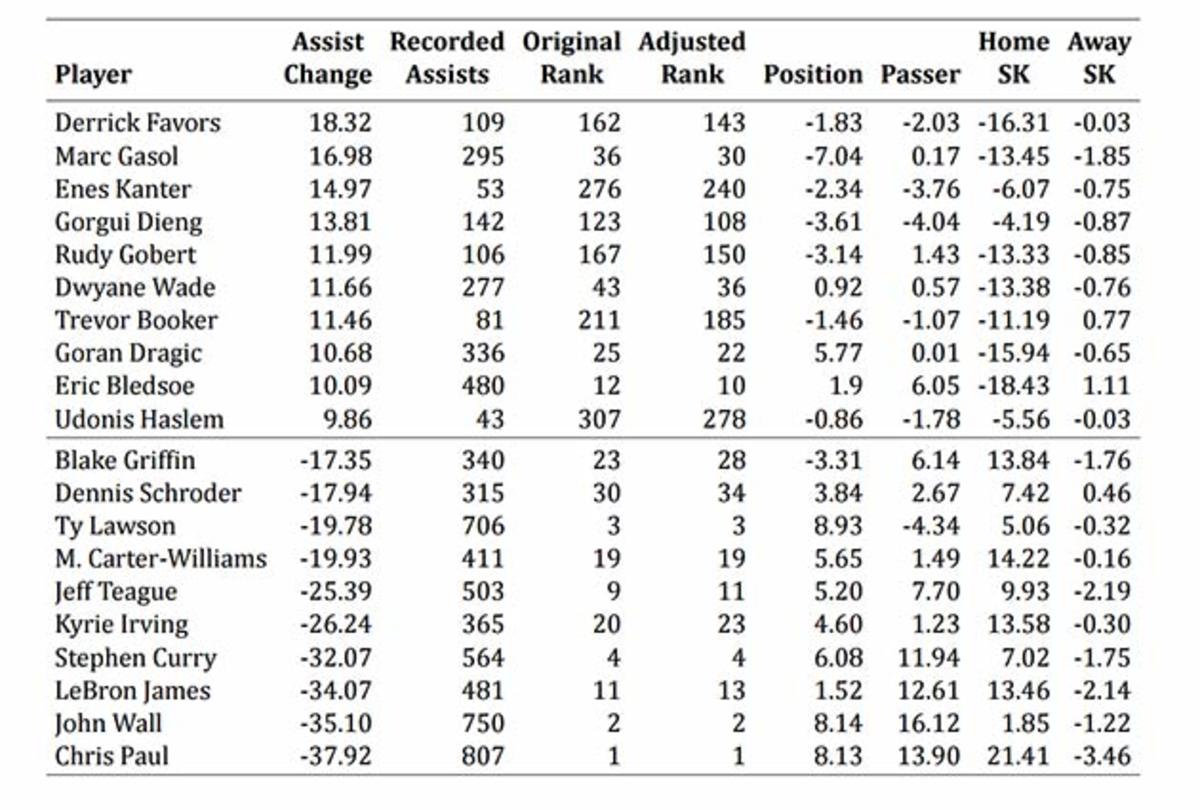
14. Dan Cervone, Luke Bornn and Kirk Goldsberry introduced a new concept at the conference called “NBA court realty.” Their paper aimed to show where players are most valuable on the court by defining “court space ownership” and infer value from SportVU spatial data. Check out some of their “heat maps” below.
From left (top): the entire NBA for 2014–15, the Warriors, Rockets and Knicks.
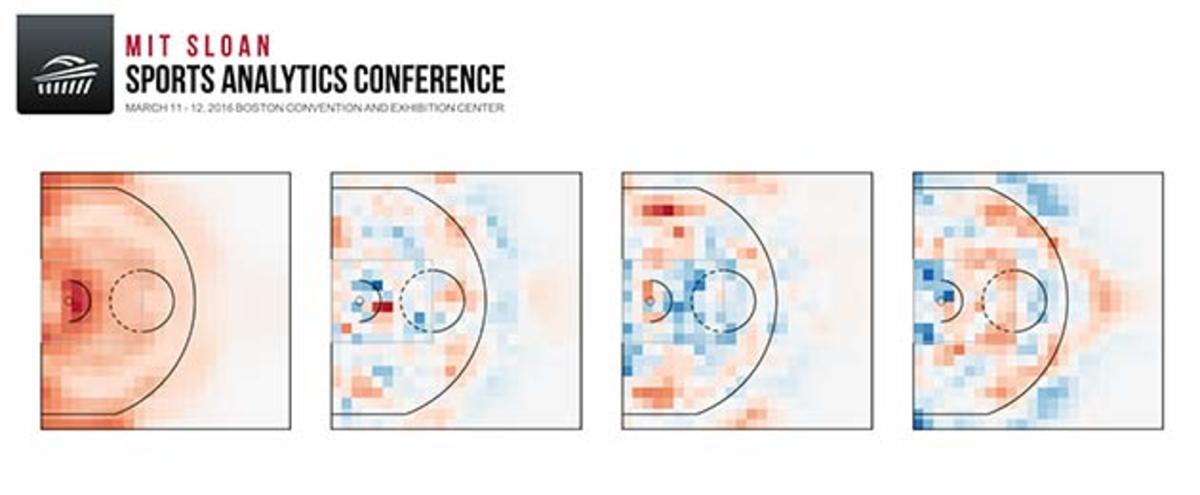
Here are a few more NBA court realty maps. The 2014–15 Warriors baseline is on the far left, try and guess the three players on the right (answers below!).

Answers: Stephen Curry, Klay Thompson and David Lee.
15. Individual player contract negotiations pale in importance to CBA negotiations, David Falk said. That’s when the real money is decided for NBA players. In the past, the players have held somewhere between 48%–57% of the revenue split, according to Falk. “Once you’re in a fixed economic relationship, the only way to make more money is make the product better.”
16. Falk believes the NBA is leaving a tremendous amount of money on the table by failing to tap into basketball-hungry markets in China and India, the world’s two most populous countries and two huge NBA countries. Falk estimated the NBA is about a $5 billion sport, but it should be $20 billion. “LeBron would make four times the money if the revenue was where it should be.”
17. One last Falk observation and some food for thought: Only 11 teams have won the NBA title in the last 35 years, which shows how poorly most NBA franchises are run.
18. Here are some brain-numbing Facebook stats for your consumption:
* Facebook had 60 million people talking about the Super Bowl during the game and 200 million interactions.
* 85% of people using social media during live TV broadcasts are using Facebook.
* 22% of all time spent on smartphones in the U.S. is on Facebook or Instagram.
* The Warriors had 700K Facebook followers in December 2013. That number skyrocketed to 5.1 million in December 2015. They’re now north of six million.
19. When SportsVU cameras were first installed in 2010, Celtics assistant GM Mike Zarren decided to quiz his point guard, Rajon Rondo, on how far he ran during an average NBA game. Rondo guessed eight miles. It turned out he ran 4.2 miles, about half what Rondo thought, but still highest on the team. The point of Zarren’s test: You would train differently for a four-mile race than an eight-mile one.
20. Using wearable technology, NBA teams can now track players’ effort and physical output in practices. Catapult Sports uses a statistic called “player load” to measure the physical burden and warn teams if players are overexerting themselves and possibly headed toward injury. As Catapult’s Brian Kopp explained, the metric takes into account all of your different movements and assigns a number to it. Essentially, the equivalent of measuring how many miles you run, but with your overall physical usage instead. “It’s based on very complicated math,” Kopp grinned.
21. Wearable technology, in fact, was one of the most frequent discussion points at the 2016 conference. Tom Thibodeau discussed how the technology needs to be practical or players won’t buy in. If it falls off or is uncomfortable, they’re out. Thibs also said the technology needs to be worn during games to produce truly valuable data. Brian Scalabrine offered his own suggestion, saying the technology should be won 24/7 by NBA players so you can find out what they’re doing at 4 AM, which isn’t that bad of an idea ...
• SHARP: Thibs Thirst rankings: Which teams need Tom Thibodeau the most?
22. Thibs told a story about trying to fix the Bulls’ frontcourt redundancy by tasking Taj Gibson with developing his three-point shot one off-season. The goal was to get Gibson to “stretch” his shot to corner threes. Unfortunately, the former Sixth Man of the Year runner-up wasn’t comfortable with the expansion. He remains a career 1-of-22 shooter from deep.
23. One college basketball factoid: FiveThirtyEight’s Nate Silver called it a “fluke” that a No. 16 seed has never upset a No. 1. He estimated a 16-seed has about a “.5%–5% chance” of winning the matchup and added No. 1 seeds are no longer as dominant as they used to be.
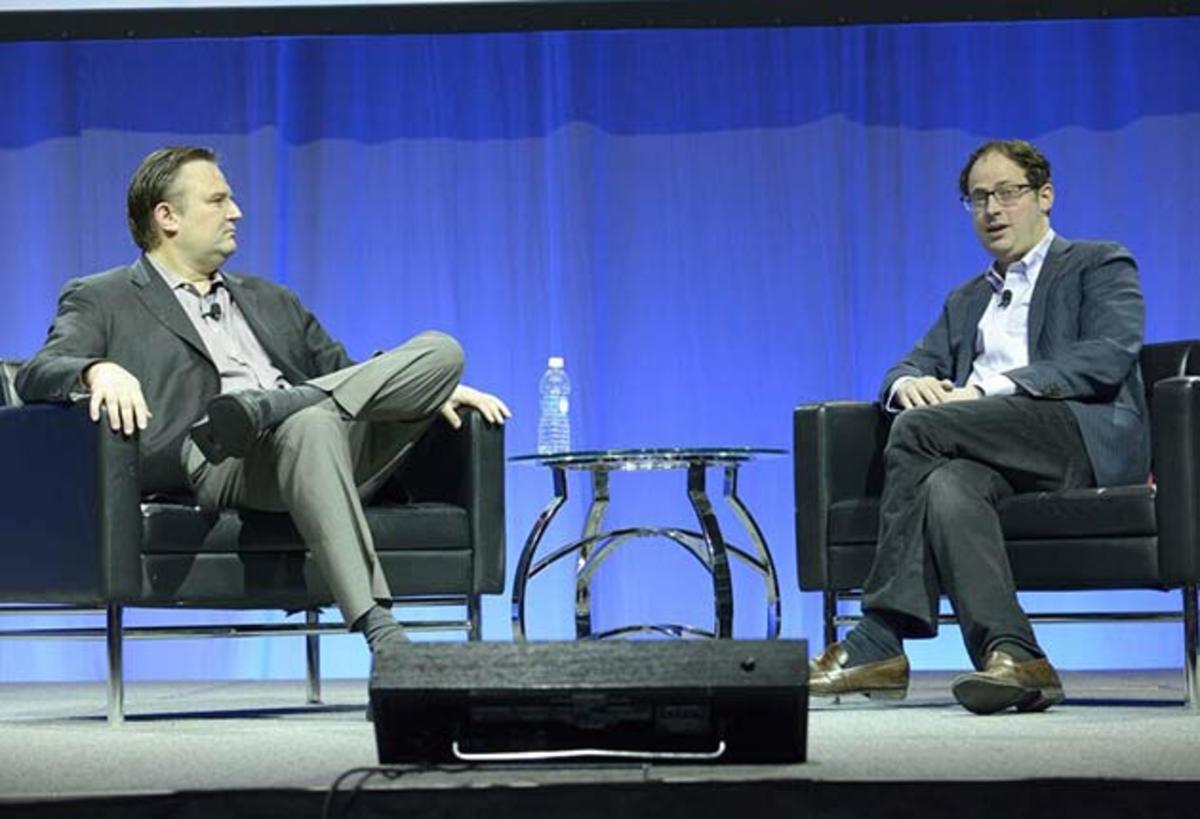
24.
25. The NBA unveiled a new program for setting its regular-season schedule, which they’ll debut this fall. Taking into factor business, structural and travel constraints, the program aims to maximize player health and fairness while supporting business opportunities (national TV games etc.). Here’s a screenshot from the new program during the presentation (note: it’s not the real 2016–17 schedule, so don’t hurt yourself squinting).
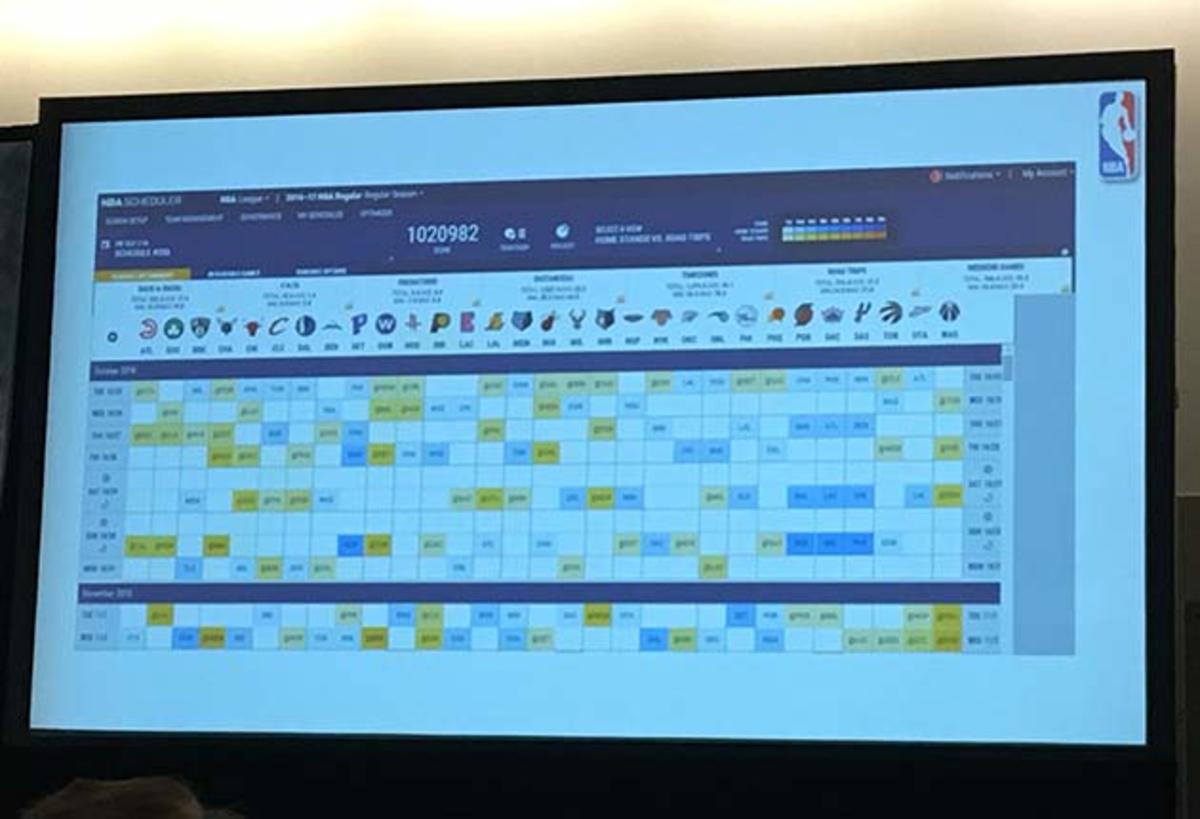
The league has made its schedule-setting a point of emphasis in recent years and yielded drastic improvements. The NBA went from 578 back-to-back games in 2014–15 to 533 this year. Even more impressive, they’ve reduced the instances of teams playing four games in five nights from 69 in ’14–15 to 27 this season.
26. There are more ways to fix the NBA’s regular-season schedule than there are atoms in the universe, according to the NBA’s Evan Wasch. What?!
27. One billion people consume NBA content, according to the NBA’s Bill Koenig. Just as impressive: the NBA is the most popular sports league in China, despite not having a team located within, oh, 7,000 miles.
28. On the Future of the Front Office presentation, panelists were asked what new front office job will exist in five years that doesn’t exist now. The consensus: Something related to psychology, chemistry or health and fitness.
Quotes
29. There were more Scalabrine jokes than research papers at Sloan. Among the best: Scal claiming he was the best fifth starter in Celtics history and Zarren replying that Scalabrine tried to use a seven-game stretch, “to justify a five-year contract." A self-deprecating jab from Scalabrine: “The smartest people at MIT can’t figure out how I had an 11-year career.” And finally one from ESPN’s Zach Lowe, noting Scalabrine’s disastrous stint with the Warriors: “He was one of the first coaches ever sent down [to the D-League].”
• FISCHER: Scalabrine’s big personality makes broadcasting a perfect fit
30. To say Jeff Van Gundy is a skeptic of “rest” analytics would be an understatement. “Utter bulls---,” the former Knicks and Rockets coach said. JVG stressed that sleep is the important factor when it comes to players’ health, not down time. “Even if you give a guy a game off, if he’s out at the club until 4, that’s not rest.” New York Daily News columnist Frank Isola piggy-backed off JVG’s comments with a fantastic idea for Sloan 2017.
I think Jeff Van Gundy broaching the subject of "clubbing" opens the door for J.R. Smith to be the keynote speaker at Sloan Conference 2017.
— Frank Isola (@TheFrankIsola) March 11, 2016
31. Van Gundy riffing on sports science analytics: “Pat Riley was at the forefront of analytics. He used to crush people about their weight and body fat.”
32. Shane Battier’s (yep, he was back this year) motto when it came to using analytics as a player: “Let the plan fail you, don’t fail the plan.”
33. David Falk: “A lawyer who represents himself has a fool for a client.” Boom, roasted!
34. Kirk Goldsberry during his “The Curry Landscape” presentation, discussing the NBA’s three-point line: “That little ribbon on the perimeter is the biggest economic factor in the behavior of players.”
35. Brian Kopp from Catapult Sports: “Data is not meant to flip things on their head.” Instead, its supposed to “reinforce things you already know.”
36. Thibodeau was asked directly about the narrative that he rode his players too hard in Chicago, playing wings like Jimmy Butler and Luol Deng almost 40 minutes per night. Thibs joked the assessment was “fair and accurate,” before going to his actual defense. “If [a player] never played more than 32 minutes and he’d never get hurt, I’d do it, but there’s no guarantee.” He explained that he would often match Jimmy and Luol up with other elite wings, like LeBron or Kevin Durant, and put them in the game as long as their opponent was playing.
Just for kicks: Here‘s a photo of Thibs explaining the intricacies of the pick-and-roll to some students (or at least I’d like to imagine that’s what's going on here).
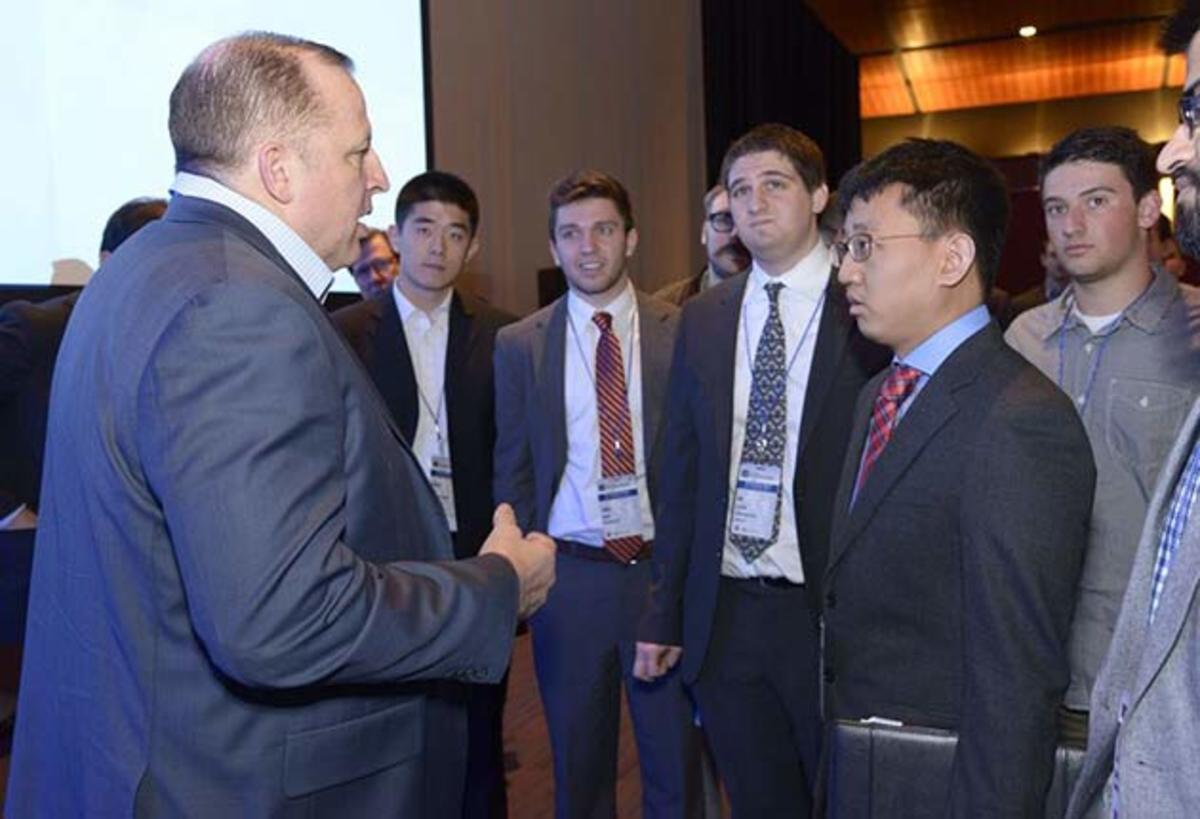
37. As Zarren told a story about different teams’ processes during the basketball analytics panel, he said, “Long term, the 76ers want to win championships,” which led to an accidental burst of laughter from the audience.
38. With all of the information we now have on injuries and sports science, some wonder why injuries continue to increase across sports. Stephen Smith, the CEO and Founder of Kitman Labs, explained the dynamic perfectly: “We’re all looking for the silver bullet, this piece of data that tells us everything. But humans are complex. One data point or one source will never tell us everything we need to know.”
• BALLARD: Want to avoid injury? NBA teams are looking to P3 for answers
39. On the same panel, Dr. David Martin, who works for the 76ers, summed up why some athletes are resistant to professional opinions about their bodies. “People don’t reject sports science, they reject sports scientists.” Without the right delivery or right approach, the information is useless.
40. Rockets GM Daryl Morey gave a candid analysis on the Rockets’ disappointing season: Morey said they didn’t handle their “relative success” from last season very well. The team went through training camp only concerned about being healthy, not getting better. And as for their on-court performance this season: “We’re just bad on defense. Defense takes the right players, the right system and the right commitment.”
• SHARP: Shooting for the moon: Why the Rockets and Sixers fail this season
Anecdotes
41. Despite the ongoing analytics revolution, Battier still says there’s a “stigma” against advanced stats among players in the locker room. The former Heat forward told a story about when he was teammates with LeBron James and they were preparing for a game against Kevin Durant and the Thunder. Battier implored LeBron to force Durant to shoot over his left shoulder on the left block. The scouting report indicated KD shot a worse percentage from that area shooting over his left than his right. LeBron listened, forced Durant left on the left block and the Thunder star missed his first two attempts and struggled to find his rhythm the rest of the game. “At that point, you got him mentally,” Battier said. “You got him in a box.”
42. The Sloan conference has been going on for a decade and Kirk Goldsberry, the former Grantlander now with the Spurs, has been a major fixture for most of its existence. So you would think they’d give Kirk a slightly bigger room when presenting his latest findings. Alas, the conference room looked like the line to get into 1OAK (if the club was a job fair for business students).
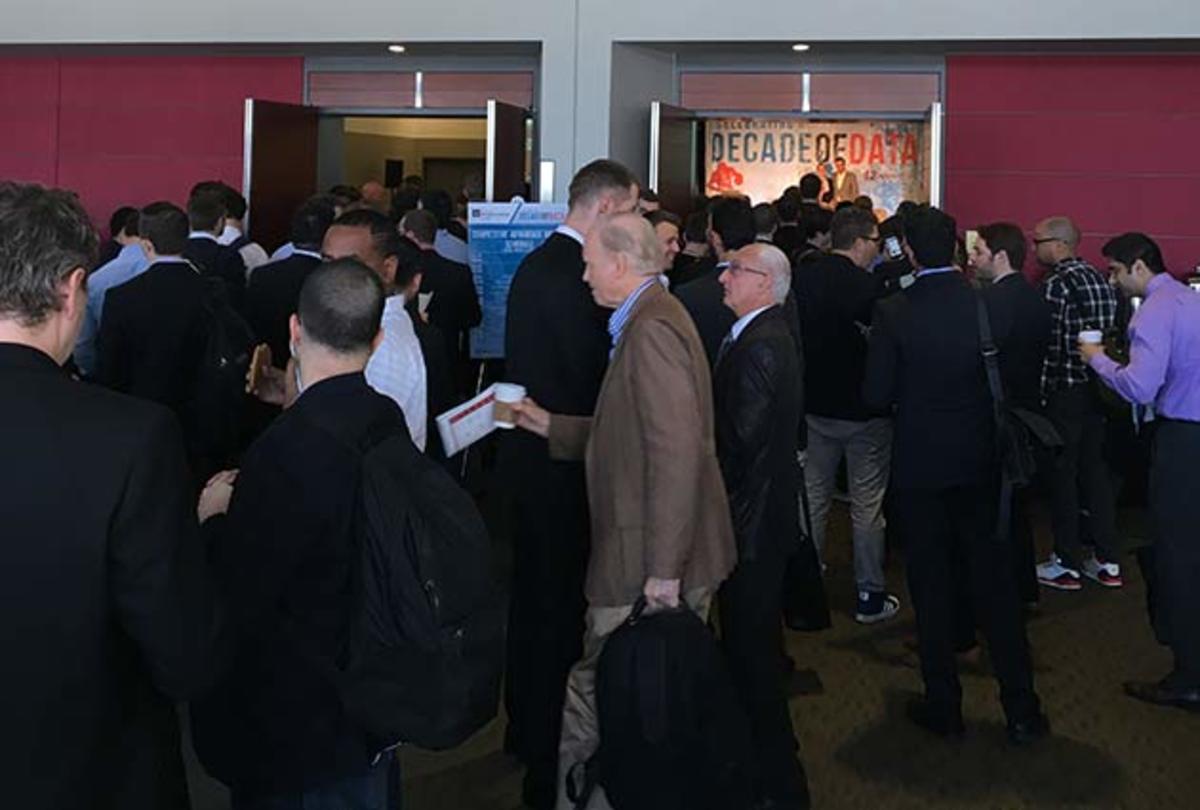
44. It’s already clear Draymond Green is one of the biggest steals in NBA draft history, going No. 35 to the Warriors in 2012. Every NBA team passed on the Michigan State product, but at least one team did have him high on their draft board. Brian Scalabrine said Celtics assistant GM Mike Zarren showed him the team’s 2012 draft board, which had Green in the top three. The other two? Anthony Davis and Jared Sullinger, who the C’s selected with the 21st pick.
• REILLY: Warriors outtakes: Curry in Shanghai, celebrities and more
45. The irony of Vinny Del Negro, Mike Brown and Scott Brooks participating in the “Modern NBA Coaching” panel was not lost on me.
46. Brown, the former Cavaliers coach, relayed a colorful LeBron anecdote: The Cavs were botching their pick-and-roll defense one night over and over. Brown called timeout and asked his team, “What do you want to do? Do you want to go under the screens? We just need to make up our mind.” LeBron, according to Brown, replied: “F--- that! We’re going to show, that’s who we are. We’re a show team.” After seeing that, Brown realized just how powerful of a leader James truly was. “I thought, ‘OK, now we have something.’”
47. Dr. David Martin was asked about Joel Embiid’s situation and provided an intriguing response about the Sixers’ approach for treating the big man’s injuries. For a player like Embiid—who began playing at age 16—there’s no database to consult, no sample size to draw conclusions from. So what do you do if there’s no experience to go off of? You “connect with experts and crowd source opinions and try and find common themes that makes sense.” More than anything: “If you don’t know the exact path to take, you tend to take a cautious path.” That would seem to be the case with the 76ers, who have kept Embiid from playing a single NBA minute since being drafted No. 2 overall in 2014.
The SI Extra Newsletter Get the best of Sports Illustrated delivered right to your inbox
Subscribe
48. Zarren said the Celtics found out from analytics that Kevin Garnett’s performance dropped dramatically after being in the game for at least four minutes, leading Doc Rivers to play his veteran star in four-minute spurts and maximize his time on the floor.
49. During the front office panel, ESPN’s Jackie MacMullan, who was moderating, asked Morey about re-signing Dwight Howard. Morey immediately replied: “Uh oh.” MacMullan pressed the Rockets GM on negotiations. He responded that the NBA’s max salary threshold keeps things simple. MacMullan asked, So you’re re-signing him? To which Morey responded: “I just said they had the concept.”
50. Falk represented Juwan Howard when he was drafted No. 5 in 1994. Glenn Robinson, who went No. 1 to the Bucks, asked the team for $100 million, setting a high ceiling for the rest of the draft class to work with. Falk said the Bucks owner at the time told Robinson’s agent, “You give me $100 million and I’ll give you the whole team.”
